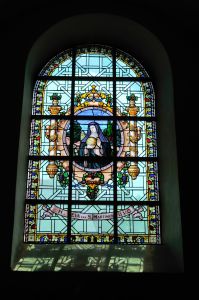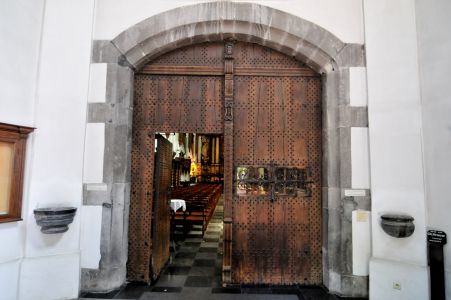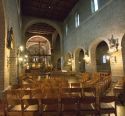Basilica | 1641-1648 | Renaissance | Catholic Church






Map
Opening hours
01 March - 31 October
Mon 8.00 - 19.00
Tue 8.00 - 19.00
Wed 8.00 - 19.00
Thu 8.00 - 19.00
Fri 8.00 - 19.00
Sat 8.00 - 19.00
Sun 8.00 - 19.00
01 November - 28 February
Mon 8.00 - 16.30
Tue 8.00 - 16.30
Wed 8.00 - 16.30
Thu 8.00 - 16.30
Fri 8.00 - 16.30
Sat 8.00 - 16.30
Sun 8.00 - 16.30
Guided tour
+32 11 31 60 06 or +32 474 77 76 04
Religious offices
Monday till Friday : 8 am
Saturday : 7.30 am
Sunday : 9.30 am
More masses in May, depending on the number of pilgrims.
Description
The church thanks its origin to a statue of Mary. Several centuries ago, travellers were regularly attacked by brigands in the region. Elisabeth van Oeteren wanted to protect them and in 1636 she placed a statue of Our Lady in an oak tree on a lonely and empty place. In 1639 a chapel was built, which was named "Our Lady Nightingale at Kortenbos". Since then, the site was very popular with Mary worshipers.
To cope with the great surge of religious people, the construction of a new baroque pilgrimage church was decided in 1641. The building plan was drawn by a Franciscan, Nicholas Ray. The church was consecrated in 1648, but during the following decades, it was extended with a portal, a transept and a tower, whose top has a lantern and corner turrets. These works were completed in 1725. Exactly two centuries later, the church received two side portals.
The outside of the church consists of simple brick walls, in which marlstone sometimes was inserted. It is a single-aisled cruciform church with a nave of four bays, a transept of two bays, a chancel with a straight bay, an east tower and a sacristy. In the north and south side of the ship, slimline, round arched windows stand out, which accentuate the verticality of the church.
The church has a plastered and whitewashed interior with a rich baroque oak-wood wainscoting, in which two confessionals were fitted by Antoon Bayens from Mechelen. The interior has been preserved almost in its original state and it is very similar to the interior of the abbey church of Averbode. The layout of the nave into bays is enhanced by flat transverse arches between cross-ribbed vaults, which connect to pilasters without capitals.
The main altar and side altars are made out of marbled wood by the Antwerp woodcutter Pieter Scheermaeckers between 1665 and 1710. Above the altar hangs a painting by Gaspar de Crayer from 1662 showing how St. Norbert adores Our Lady. Other altarpieces show Our Lady with St. Norbert and St. Augustine and The Western Auxiliary Saints or Holy Helpers. In addition, the church owns eighteen votive paintings of the Flemish School and twelve paintings with Premonstratensian Saints by Abraham van Diepenbeek.
The terracotta figurine of Our Lady of Kortenbos still has a central place in the front of the church.
KIKIRPA : Photo-library online
See the treasure of this church online on erfgoedplus.be
Photos
Media
Remarkable elements
High altar
The back wall of the choir is completely filled by the mighty high altar of marbled wood. With its exceptional high elevation, the Antwerp artist Pieter Scheenmaekers has managed to accentuate the depth of the room. The fronton is supported by six round white columns with gold capitals.
Altar painting
This particularly valuable altar painting by Caspar de Crayer (1584-1669), one of the best painting mates of Peter Paul Rubens, was manufactured in 1662. It is one of the later works of this painter in which he has illustrated his personal relation to “Our Lady of Kortenbos”. Mary is seated on a throne, she holds baby Jesus, who is standing on her right knee.
Organ
On the left platform stands an organ. This instrument was built by organ manufacturer Clerinx from Sint-Truiden in 1867. It has 8 stopknobs, and two manuals/pedals.
Side altars
The side altar in the right transept is dedicated to St. Roch. He stands on top of the altar, above a painting which shows a healing by him. The side altar in the left transept is dedicated to the Blessed Virgin and to Mary Mother of God.
Wooden wainscotting
The beautiful decoration of the nave with oak paneling is applied over the full length of the interior walls below the parapet of the windows. These artistically exquisite specimens of woodcarvings were created in 1650 by the artist Antoon Baeyens from Mechelen. Eight confessionals are incorporated in the wooden decorations.
Statue of grace
Until the restoration, this statue of grace was displayed in expositorium above the tabernacle. Nowadays it is stands on its former brass grace altar again, on the left side of the choir. The statue of grace is made out of clay and has a height of 18.5 centimetres. It represents the Mother of God with baby Jesus in her arms. The statue of grace was miraculously found in a centuries-old oak tree in 1609.






























